Serving 644 students in grades 6, Crossroads Intermediate ranks in the bottom 50% of all schools in South Carolina for overall test scores (math proficiency is bottom 50%, and reading proficiency is bottom 50%).
The percentage of students achieving proficiency in math is 23% (which is lower than the South Carolina state average of 41%). The percentage of students achieving proficiency in reading/language arts is 34% (which is lower than the South Carolina state average of 52%).
The student:teacher ratio of 12:1 is lower than the South Carolina state level of 14:1.
Minority enrollment is 66% of the student body (majority Black), which is higher than the South Carolina state average of 53% (majority Black).
Quick Stats (2025)
- Grades: 6
- Enrollment: 644 students
- Student:Teacher Ratio: 12:1
- Minority Enrollment: 66%
- Overall Testing Rank: Bottom 50% in SC
- Math Proficiency: 23% (Btm 50%)
- Reading Proficiency: 34% (Btm 50%)
- Science Proficiency: 37% (Btm 50%)
- Source: National Center for Education Statistics (NCES), SC Dept. of Education
Top Rankings
Crossroads Intermediate ranks among the top 20% of public schools in South Carolina for:
Category
Attribute
Diversity
Student Attention
School Overview
Crossroads Intermediate's student population of 644 students has declined by 20% over five school years.
The teacher population of 52 teachers has declined by 13% over five school years.
Grades Offered
Grades 6
(offers virtual instruction)
(offers virtual instruction)
Total Students
644 students
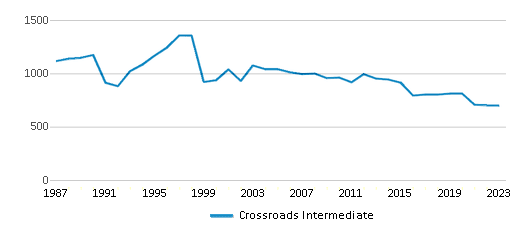
Gender %
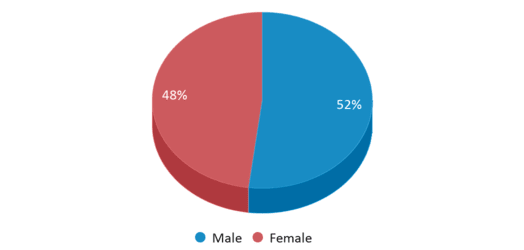
Total Classroom Teachers
52 teachers
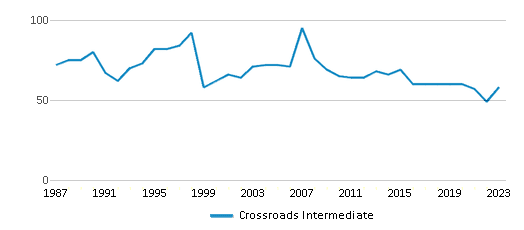
School Rankings
Crossroads Intermediate ranks within the bottom 50% of all 1,154 schools in South Carolina (based off of combined math and reading proficiency testing data).
The diversity score of Crossroads Intermediate is 0.66, which is less than the diversity score at state average of 0.67. The school's diversity has stayed relatively flat over five school years.
Overall Testing Rank
#921 out of 1154 schools
(Bottom 50%)
(Bottom 50%)
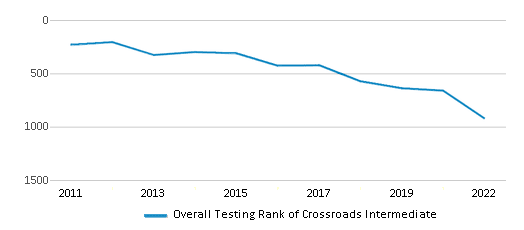
Math Test Scores (% Proficient)
23%
41%
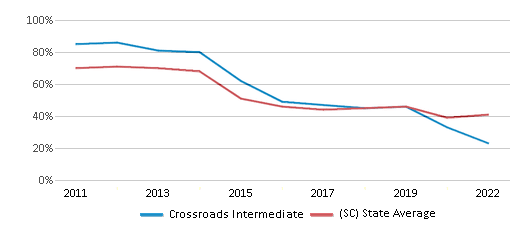
Reading/Language Arts Test Scores (% Proficient)
34%
52%
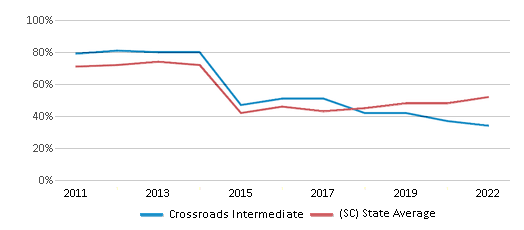
Science Test Scores (% Proficient)
37%
50%

Student : Teacher Ratio
12:1
14:1
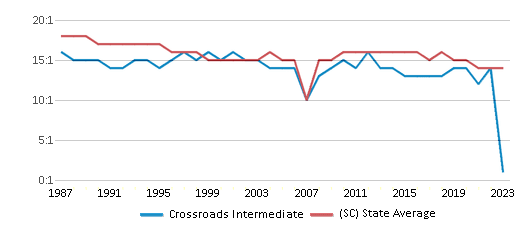
American Indian
n/a
n/a
Asian
2%
2%
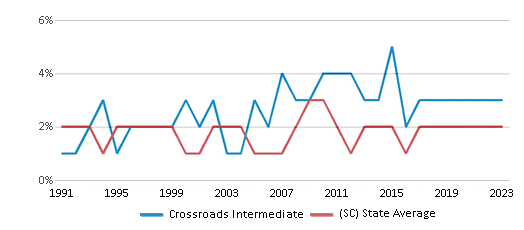
Hispanic
9%
14%
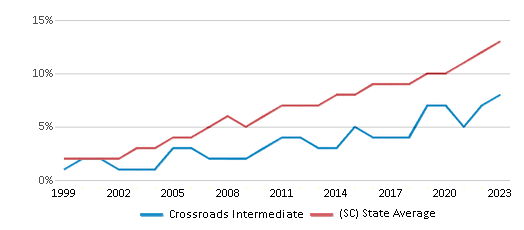
Black
46%
31%
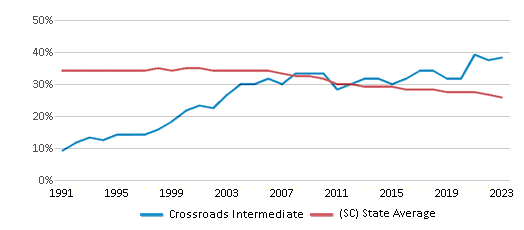
White
34%
47%
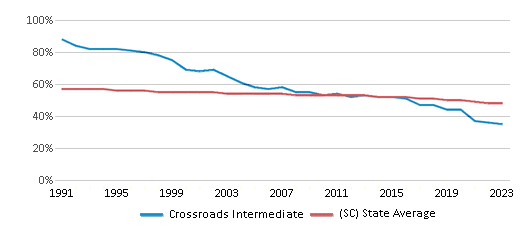
Hawaiian
n/a
n/a
Two or more races
9%
6%
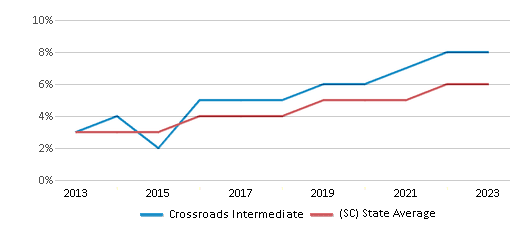
All Ethnic Groups
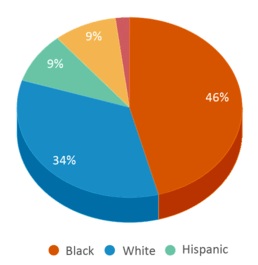
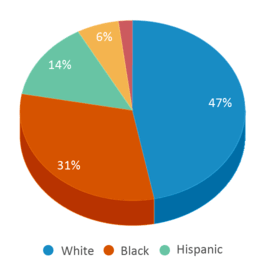
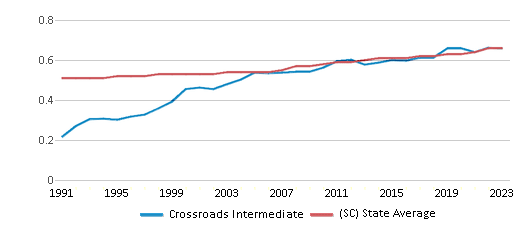
Participates in the National School Lunch Program (NSLP)
Yes
Eligible for Free Lunch
67%
67%
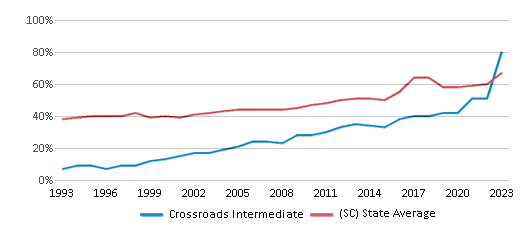
Eligible for Reduced Lunch
5%
3%
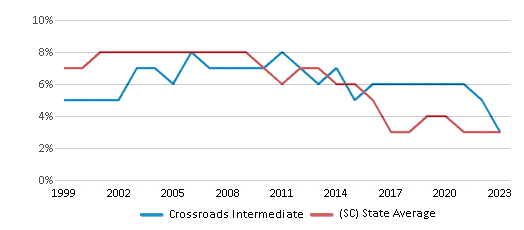
School Statewide Testing
School District Name
Source: National Center for Education Statistics (NCES), SC Dept. of Education
Profile last updated: 02/09/2025
Frequently Asked Questions
What is Crossroads Intermediate's ranking?
Crossroads Intermediate is ranked #921 out of 1,154 schools, which ranks it among the bottom 50% of public schools in South Carolina.
What schools are Crossroads Intermediate often compared to?
Crossroads Intermediateis often viewed alongside schools like Irmo Middle School by visitors of our site.
What percent of students have achieved state testing proficiency in math and reading?
23% of students have achieved math proficiency (compared to the 41% SC state average), while 34% of students have achieved reading proficiency (compared to the 52% SC state average).
How many students attend Crossroads Intermediate?
644 students attend Crossroads Intermediate.
What is the racial composition of the student body?
46% of Crossroads Intermediate students are Black, 34% of students are White, 9% of students are Hispanic, 9% of students are Two or more races, and 2% of students are Asian.
What is the student:teacher ratio of Crossroads Intermediate?
Crossroads Intermediate has a student ration of 12:1, which is lower than the South Carolina state average of 14:1.
What grades does Crossroads Intermediate offer ?
Crossroads Intermediate offers enrollment in grades 6 (offers virtual instruction).
What school district is Crossroads Intermediate part of?
Crossroads Intermediate is part of Lexington 05 School District.
School Reviews
4 6/26/2021
I learned so much at this school. Not only did I learn academics, I also learned social skills and how the world's going to be. I went to the school in the 2020 to 2021 school year during covid. I know I didn't get the real experience of how the school would be on a normal year but I had a good experience The teachers are nice and good teachers for the most part especially Mrs Davenport who taught me so much about math and made me feel like I could do it because I always thought I would never be good at math. Yes, there are kids that curse and try to get into fights but those types of people will be everywhere and to be with this group of kids taught me that the world isn't all butterflies and rainbows and that you just need to find your group of people that treats you the way you want to be treated.
Review Crossroads Intermediate. Reviews should be a few sentences in length. Please include any comments on:
- Quality of academic programs, teachers, and facilities
- Availability of music, art, sports and other extracurricular activities
Recent Articles

What Is A Charter School?
Explore the world of charter schools in this comprehensive guide. Learn about their history, how they operate, and the pros and cons of this educational innovation. Discover key facts about charter schools, including admission policies, demographics, and funding, as well as what to look for when considering a charter school for your child.

10 Reasons Why High School Sports Benefit Students
Discover the 10 compelling reasons why high school sports are beneficial for students. This comprehensive article explores how athletics enhance academic performance, foster personal growth, and develop crucial life skills. From improved fitness and time management to leadership development and community representation, learn why participating in high school sports can be a game-changer for students' overall success and well-being.

February 05, 2025
Understanding the U.S. Department of Education: Structure, Impact, and EvolutionWe explore how the Department of Education shapes American education, from its cabinet-level leadership to its impact on millions of students, written for general audiences seeking clarity on this vital institution.









